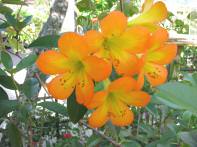This plant may be available to buy
Click the banana to see

|
click pic to enlarge |
|
Zone 10 Said to be "semi" epiphytic, this rare-to-see wonderful plant is a show-stopper in protected, shaded areas of your landscape The photo above shows the orange/yellow tropical rhododendron --- our favorite color that we've seen in person. There is a white, a pink, a purple, red and approximately 400 others. The plant in the photo is living in a standard 3-gallon nursery pot. It has been fussed over and professionally pruned to maximize blooming tips First discovered in 1843 in the South Pacific, these plants are native to counties like Indonesia, Borneo and Malaysia. They are often found growing in rock crevices and in trees This tropical is not really difficult to grow. The primary considerations for your rhododendron are drainage and location. The correct exposure must be totally protected from wind and North side cold. A protected East exposure, or perhaps with a partial South exposure is required. High broken shade like under a Royal Poinciana is the best Perfect drainage, high humidity, protection from direct sun, year around warm weather and good air circulation are the keys to happy plants click pic to enlarge You may keep your tropical rhododendron in a container or plant it in the ground, but a pot is the best for total (climate/exposure) control We have seen specimens grow to close to six feet tall. However, we recommend plants be kept lower for better bloom performance, by pruning to a more bushy (versus sprawling) habit Best flower performance is had with pruning/pinching to create the maximum number of branch tips from which flowers will develop in clusters. The more tips, the more clusters, the more luxurious your flower display This plant's growth habit is along thin stems with little solid wood at the base. Left naturally, the plant appears leggy and quite open. In the wild it is often attached into rocky soils able to anchor the plant Blooms in South Florida are in the cooler months, perhaps as early as November, but every year is a little different. Blooms can continue to be produced for several months. Propagate from new growth tip cuttings in the spring. Feed sparingly |

